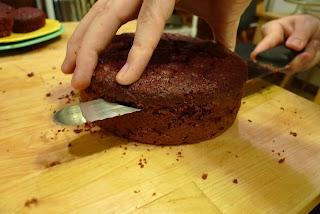In this case, chocolate stout cake with chocolate stout icing. It's all about the beer and the chocolate, which are a delicious combination. The bitterness of the beer makes the cake not-too-sweet, which I think brings out the chocolate flavor instead of hiding it behind a wall of sugar as chocolate cakes often do. I adapted a Bon Appetit recipe for the cake (via Epicurious and Smitten Kitchen) and a random internet recipe for the icing:
Chocolate Stout Cake
(enough for one 9" or two 6" round cakes)
2/3 c. stout
2/3 c. butter
1/2 c. cocoa (dutch processed is best)
2 eggs
1/2 c. greek yogurt (homemade!)
1 1/3 c. flour
1 1/3 c. sugar
1 t. baking soda
1/2 t. salt
bake ~35 minutes at 350 degrees
Frosting
1 stick butter
1/3 cup cocoa
1/3 cup stout
powdered sugar
(enough to make the frosting the right texture. My base recipe called for 3 1/2 cups, I have no idea how much I used. Measuring how much sugar goes into frosting is just a recipe for feeling guilty about eating too much sugar, in my opinion)
Whisk together the eggs and yogurt (sour cream works too, that's what the original recipe called for) together in a large bowl. Once the Chocolate/butter/stout mixture is cooled, add it to the egg/yogurt mixture. I like to be paranoid about the temperature in this step, to avoid the possibility of some sort of disgusting scrambled egg mixture being created with the addition of too much heat.
Next, mix all of the dry ingredients together, then combine with the wet ingredients. Recipes often tell you to use separate bowls, but I usually find it works to mix the dry ingredients gently on top of the wet ingredients--then you have one less bowl to wash. At this point, don't mix too much. Beat the whole mixture together a couple of times with the whisk, then switch to a spatula and fold it together as gently as possible. Nobody likes a tough cake!
Next, pour the batter into your cake pan(s). This recipe fills two 6" round pans, which is what I used, or one 9" round. I like to butter the pans, line the bottom with a circle of parchment paper, and then put some more butter on top of that. It's sad when you have to mangle your cake just to get it out of the pan, and the layer of parchment really makes a big difference.
Place the pans in the center of the over, pre-heated to 350. Bake until a toothpick or knife comes out clean, until the internal temperature reaches approximately 210 degrees, or for 35 minutes, whichever results in a cake that's done to your liking. Hey, despite all of the chemistry involved, baking is really more of an art than a science!
Let the cake cool in the pan for 10 minutes or so, then remove from the pan and cool to room temperature on a wire rack. Finally, layer and frost your cake! I like to cut each cake into two layers, using a bread knife. If you're careful, you can end up with fairly even layers--as you might be able to tell from this picture, I was not very careful. Obviously I should have had Anthony cut it instead, like I usually do.
To make the icing, simply soften the butter and mix with the rest of the ingredients. This time you don't have to worry about over-mixing! Adjust the amount of powdered sugar as needed, depending on the humidity, how well you measure the wet ingredients...or how "soft" your butter ends up. I accidentally melted the butter completely, so I added a lot of extra sugar to try to make the frosting stiff enough to actually put on the cake without it oozing off. One of the advantages of having to add more sugar was that we ended up with some extra frosting at the end, which was delicious spread on graham crackers.
Then eat and enjoy! I would say that the reason there's no "finished" after picture is that the cake was so delicious that we ate the entire thing before I could take a picture, but that would be kind of disgusting. In real life I was just too lazy to take a picture at any time during the week and a half or so that we spent eating this cake.
Someday I'm going to post an actual healthy recipe on this blog, but dessert recipes are so much more exciting! Anthony and I actually do eat a lot of vegetables, generally. So far the Green Tomato Pie is still winning for the most vegetable-y recipe on this blog (if you count tomatoes as a vegetable not a fruit...), which is really a little sad. So stay tuned for some nutrition in the near future! Maybe.






























